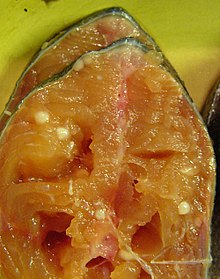
Back Henneguya zschokkei German Henneguya zschokkei Spanish Henneguya zschokkei French Henneguya zschokkei ID Henneguya zschokkei Italian 헤네구야 살미니콜라 Korean Henneguya zschokkei Polish Henneguya zschokkei Portuguese Henneguya zschokkei Russian Henneguya zschokkei Ukrainian
| Henneguya zschokkei | |
|---|---|

| |
| Henneguya zschokkei in salmon | |
| Scientific classification | |
| Domain: | Eukaryota |
| Kingdom: | Animalia |
| Phylum: | Cnidaria |
| Class: | Myxosporea |
| Order: | Bivalvulida |
| Family: | Myxobolidae |
| Genus: | Henneguya |
| Species: | H. zschokkei
|
| Binomial name | |
| Henneguya zschokkei (Gurley, 1894)
| |
| Synonyms[1] | |
| |
Henneguya zschokkei or Henneguya salminicola is a species of a myxosporean endoparasite. It afflicts several salmon in the genera Oncorhynchus and Salmo,[2][3] where it causes milky flesh or tapioca disease.[1] H. zschokkei is notable for its reliance on an exclusively anaerobic metabolism as well as its lack of mitochondria and mitochondrial DNA.[4] It is the only known multicellular animal that does not require oxygen to survive.[5]
- ^ a b "Henneguya salminicola". fishpathogens.net. Oregon State University. Oregon Department of Fish and Wildlife. Archived from the original on 2020-02-28. Retrieved 2020-02-28.
- ^ Ward, Henry B. (1919). "Notes on North American Myxosporidia". The Journal of Parasitology. 6 (2): 49–64. doi:10.2307/3270895. JSTOR 3270895. S2CID 88435361. Archived from the original on 2021-08-17. Retrieved 2021-08-04.
- ^ Greenwood, Veronique (28 February 2020). "This Parasite Doesn't Need Oxygen to Survive - But that's not the weirdest thing about this jellyfish cousin that turns up in the muscles of salmon". The New York Times. Archived from the original on 30 April 2023. Retrieved 5 March 2020.
- ^ Cite error: The named reference
:0was invoked but never defined (see the help page). - ^ "First Known Non-oxygen Breathing Animal".